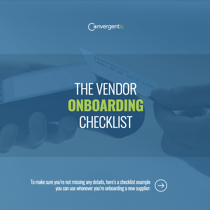In the dynamic and competitive business landscape of today, vendor visibility holds a pivotal role in the success and growth of organizations. As businesses strive to optimize their operations, streamline supply chains, and deliver exceptional products and services, establishing strong relationships with vendors becomes increasingly vital. At the heart of nurturing these relationships lies the need for enhanced vendor visibility.
Vendor visibility refers to the degree to which businesses can access and interact with their vendors, gaining insights into their performance, capabilities, and reliability. It encompasses effective communication, seamless collaboration, and real-time data accessibility, enabling businesses to make informed decisions and drive mutual success. To unleash the full potential of vendor visibility, organizations are increasingly turning to a powerful solution: the vendor portal. Acting as a centralized platform, the vendor portal serves as a digital gateway between businesses and their vendors. It transforms the way businesses engage with their vendor networks, serving as a hub for information exchange, collaboration, and relationship management.
Understanding Vendor Visibility
Vendor visibility can be defined as the extent to which businesses have access to and can effectively engage with their vendors. It encompasses various aspects such as communication, collaboration, and data sharing that enable businesses to gain insights into their vendor networks. The level of vendor visibility directly impacts the success and growth of businesses, as it influences the efficiency of supply chains, the quality of products and services, and overall operational effectiveness.
When businesses have enhanced vendor visibility, they can make informed decisions regarding vendor selection, performance evaluation, and risk management. By having real-time access to vendor data, businesses can proactively address issues, identify opportunities for improvement, and drive operational excellence. Strong vendor visibility fosters transparency, trust, and effective collaboration, which are essential for building long-term partnerships and achieving mutual success.
Enhanced Communication and Collaboration
In any business relationship, effective communication is vital for success. This principle holds true when it comes to the collaboration between vendors and businesses. Clear and open lines of communication are essential to ensure that both parties are on the same page, understand each other's expectations, and can address any concerns or issues that may arise. When communication between vendors and businesses is strong, it fosters a sense of trust and transparency. It allows for smooth coordination, efficient problem-solving, and effective decision-making. Timely and accurate information exchange ensures that both parties have the necessary details to meet deadlines, deliver quality products or services, and maintain a positive working relationship.
To enhance communication and collaboration with vendors, many businesses are turning to vendor portals. A vendor portal is a centralized platform that provides a secure and accessible space for vendors and businesses to interact, exchange information, and collaborate effectively. By utilizing a vendor portal, businesses can streamline communication channels, eliminating the need for multiple emails, phone calls, or in-person meetings. Vendors can access important documents, such as purchase orders, contracts, or invoices, in real-time, ensuring that everyone has the latest information at their fingertips.
Streamlined Vendor Management
Managing vendors can be a complex task, particularly when there is no centralized system in place. Without a streamlined approach, businesses often face various challenges in vendor management. These can include difficulties in tracking vendor performance, disorganized communication channels, and the lack of a unified platform for documentation and collaboration. These challenges not only hinder efficiency but also increase the risk of miscommunication, delays, and subpar outcomes.
How a Vendor Portal Simplifies Vendor Management Processes
Enter the vendor portal—a game-changer in simplifying vendor management processes. A vendor portal acts as a centralized hub, bringing together all the necessary components for effective vendor management. It provides a secure and user-friendly interface where businesses can easily interact with their vendors, track performance, and exchange vital information.
With a vendor portal, businesses can streamline vendor onboarding and documentation processes. Vendors can conveniently submit necessary documents, such as contracts, insurance certificates, or certifications, through the portal, saving time and reducing administrative burden. This centralized approach ensures that all required information is readily accessible and up to date.
Enhancing Trust and Transparency
Trust forms the foundation of successful vendor relationships, and transparency plays a crucial role in building that trust. By increasing transparency in vendor interactions, businesses can establish an environment of openness, honesty, and accountability. This transparency starts with clear and effective communication, ensuring that both parties have a shared understanding of expectations, deliverables, and timelines. Regular updates, progress reports, and status meetings help maintain transparency throughout the vendor engagement.
Transparency also extends to financial aspects, such as pricing, invoicing, and contract terms. Providing clear and detailed information about costs and payment processes builds trust by eliminating surprises and ensuring fairness. Additionally, being transparent about any challenges or issues that may arise during the vendor relationship demonstrates a commitment to open dialogue and collaborative problem-solving.
How a Vendor Portal Promotes Transparency
A vendor portal plays a significant role in promoting transparency and strengthening relationships with vendors. Through a centralized platform, businesses can provide vendors with access to key information, including project details, specifications, and timelines. This transparency enables vendors to have a clear understanding of the project scope, expectations, and their role in the process.
Moreover, a vendor portal facilitates document sharing and collaboration. Vendors can securely upload relevant documents, such as proposals, contracts, and deliverables, fostering transparency and ensuring that all parties have access to the latest versions. This shared visibility promotes trust and reduces the potential for misunderstandings or miscommunication.
Importance of Vendor Visibility for Business Success
The importance of vendor visibility for business success cannot be overstated. A vendor portal provides businesses with enhanced visibility into their vendor relationships, allowing for better monitoring, data-driven decision-making, and improved performance management.
By embracing vendor portals, businesses can strengthen their vendor relationships, streamline processes, and position themselves for long-term success in a competitive market.


